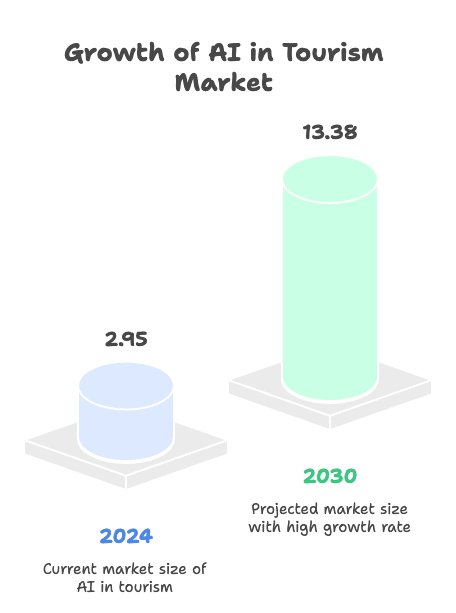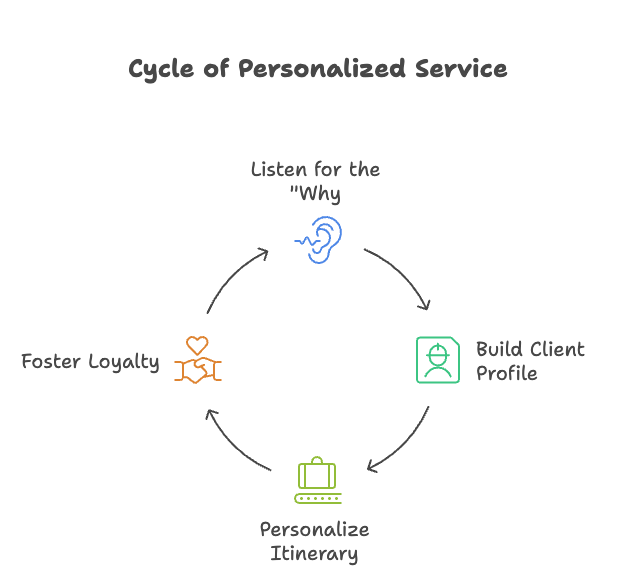A client approaches you, phone in hand, their face a mixture of excitement and pride. “Look at this,” they say, showing you a perfectly structured, day-by-day itinerary for a two-week trip to Italy, complete with museum tickets, restaurant suggestions, and train schedules. “An AI planned this for me in 30 seconds. For free.”
For any tour operator, this scenario is no longer a distant hypothetical; it’s a rapidly emerging reality. The rise of sophisticated AI in travel, capable of generating complex, bookable itineraries in the blink of an eye, presents what many perceive as an existential threat. It’s a moment of reckoning that is forcing the industry to ask a tough question: if a machine can handle the logistics, what is a human operator’s value?
But this is not an obituary. This is a call to arms. The proliferation of AI travel planners doesn’t mark the end of the tour operator; it signals the end of the operator as a mere logistical coordinator. The very technology that threatens to commoditise basic itinerary planning is also creating a massive opportunity for true travel experts to differentiate themselves. The future of travel belongs not to those who can simply book a trip, but to those who can craft an unforgettable experience. This isn’t about survival; it’s about evolution.
The Unmistakable AI Advantage
To carve out a defensible niche, we must first be brutally honest about what our new competitors do exceptionally well. AI-powered travel planners, from standalone apps like Mindtrip to integrated features within Google Gemini and ChatGPT, leverage immense computational power to deliver on speed, scale, and data-driven personalisation. The AI in tourism market is not a fledgling experiment; it’s a juggernaut projected to soar from USD 2.95 billion in 2024 to USD 13.38 billion by 2030, with a staggering 28.7% compound annual growth rate.

Here’s what they master:
-
Blistering Speed and Data Aggregation:
An AI can analyse thousands of flight options, hotel prices, and customer reviews across countless websites in seconds—a task that would take a human agent hours, if not days.
-
Data-Point Personalisation:
These tools excel at creating tailored itineraries based on explicit user prompts (“I’m a vegetarian who loves modern art and has a $3,000 budget”) and implicit behavioural data, like your past travel patterns. Over 40% of travellers are already using these tools, primarily to create itineraries optimised for their personal interests.
-
Dynamic Adaptation:
AI planners can adjust recommendations in real-time. If a flight is delayed or the weather turns sour, the system can suggest alternative indoor activities or re-optimise the schedule on the fly.
-
Cost Optimisation:
Tools like Hopper have long used predictive analytics to forecast price fluctuations, advising travellers on the optimal time to book flights and hotels to maximise savings.
This suite of capabilities has effectively commoditised the basic, functional itinerary. This is the new baseline. Competing on these terms is a losing battle. The strategic imperative, therefore, is not to be a faster bot, but to offer something the bot can never be.
The Human Value Proposition: Your Irreplaceable Edge

While AI operates on data and algorithms, human tour operators work with dreams, emotions, and relationships. The very limitations of AI—its lack of genuine empathy, its inability to build trust, and its confinement to publicly available data—are the fertile ground where you can build a thriving, future-proof business. Here are the three strategic pillars to build upon.
Pillar 1: Hyper-Personalisation and the Human Touch
AI offers personalisation; you must deliver hyper-personalisation. There is a profound difference. AI personalisation is data-matching. It connects a user’s stated preferences to a database of options. Human hyper-personalisation is empathy-driven solution design. It uncovers the unstated needs, anxieties, and aspirations behind a trip.
This isn’t just a feel-good concept; it’s a market demand. Over 80% of travellers report that they want personalised experiences, with a third willing to pay up to a 20% premium for it.
To achieve this, operators must move from being order-takers to being consultative trip architects. This starts with the discovery process. While a pre-booking questionnaire is a good start for gathering data, the real magic happens in a one-on-one conversation. This is where you can:
-
Listen for the “Why”:

An AI can process a request for a “family trip to Costa Rica.” A human expert, through active listening, can discern that this is a multi-generational trip with a grandmother who has mobility concerns, a teenager who is easily bored, and parents desperate for a few hours of relaxation. The resulting itinerary isn’t just a collection of activities; it’s a carefully balanced solution that accounts for pacing, diverse interests, and complex emotional dynamics—something AI simply cannot grasp.
-
Build a Client Profile:
Like the best hospitality brands, you can build a deep understanding of your clients over time, noting their preferences, anniversaries, and travel style. When a client feels truly seen and understood, their loyalty transcends price. They are no longer just a customer; they are your client.
Hyper-personalisation is not a feature you add; it is the service you provide. It transforms your role from a booking agent into a trusted travel consultant, building relationships that an algorithm can never replicate.
Pillar 2: Curation and Exclusive Access
AI’s universe is the public internet. If it’s on a booking platform, in a review, or on a public website, AI can find it. Your greatest competitive advantage, therefore, is to offer experiences that live outside this universe. This is about building a moat of exclusivity that no algorithm can cross.
This strategy requires shifting focus from booking existing inventory to creating your own proprietary products through human relationships. It’s a long-term investment in building a network of local partners—chefs, artisans, historians, winemakers, and community leaders—that grants your clients access to the un-bookable.
Consider these real-world examples of an unassailable competitive edge:
-
Luxury Gold offers clients dinner with a former All Blacks rugby player in New Zealand or a private meeting with a survivor of the Hiroshima atomic bomb in Japan.
-
Carrani Tours holds an exclusive partnership with the Vatican Museums, granting their guests early admission and access to areas closed to the general public.
-
A boutique operator might arrange a private, after-hours tour of a gallery with the curator, a cooking class in the home of a celebrated local chef, or a behind-the-scenes visit to a family-run vineyard.
These experiences cannot be found on Expedia or generated by a chatbot. By creating them, you fundamentally change your position in the market. You are no longer just an intermediary bundling public services; you are the originator of a unique and scarce product. This is the ultimate defence against the survival of tour operators challenge—you are no longer competing in the same game.
Pillar 3: Building Community and Shared Experiences
AI is a profoundly isolating technology. It serves the individual. But travel, at its best, is about connection—with fellow travellers and with the soul of a destination. This human need for belonging is a powerful force that tour operators are uniquely positioned to harness.
Fostering Traveller-to-Traveller Bonds:
The structure of a tour can be intentionally designed to build community. Companies like G Adventures have built a global brand around the principle of small group travel, typically capping tours at 10-12 people to foster a natural sense of camaraderie. Furthermore, by creating themed tours (culinary, photography, wellness, solo travel), you pre-assemble a group of like-minded individuals, accelerating the formation of lasting bonds.
Deepening Traveller-to-Destination Bonds:
Leading operators like G Adventures and Intrepid Travel have pioneered a model known as “Community Tourism“. This goes beyond simple sightseeing to create deep, authentic connections by:
-
Partnering with local communities to offer experiences like homestays and meals with local families.
-
Ensuring that a significant portion of the tour cost stays directly within the local economy, a powerful story that they communicate with metrics like the “Ripple Score“.
-
Turning travel into a force for good, which builds a powerful brand identity and attracts travellers who share those values.

The journey doesn’t have to end when the trip does. By creating online spaces like private Facebook groups, you can extend the life of the community, allowing travellers to share memories and prospective clients to see authentic, user-generated proof of the experiences you offer. When you successfully build a community, you are no longer just selling a trip; you are offering access to a tribe.
The Future is Hybrid: Using AI as Your Co-Pilot
The smartest operators will not fear AI; they will wield it. Instead of viewing AI as a front-office competitor, see it as the ultimate back-office co-pilot—a tool to handle the tedious, time-consuming tasks that get in the way of high-value human interaction. This is the pinnacle of travel industry innovation.
A study from MIT found that companies that masterfully combine human talent with AI achieve a 650% higher performance than average. By strategically adopting AI, you can create a virtuous cycle: automate the backend to free up your team to focus on the human-centric pillars of hyper-personalisation, exclusive access, and community building.
Consider using AI for:
-
Operational Logistics: Use AI for predictive demand forecasting to optimise staffing, route optimisation to design more efficient trips, and dynamic pricing to maximise revenue.
-
Sales and Service Automation: Implement AI-assisted quoting tools to generate initial itineraries for agent review in minutes, not hours. Use chatbots to provide 24/7 answers to frequently asked questions, freeing your human team to handle complex, high-touch problem-solving.
-
Marketing and Content: Leverage generative AI to help draft social media posts, blog outlines, or email newsletters, which your team can then infuse with your unique brand voice and expertise.
By letting the bots handle the bits and bytes, you empower your people to create the magic.

Conclusion: The Enduring Power of the Human Touch
The rise of AI in travel is not a death knell for tour operators; it is a powerful filter. It will undoubtedly challenge those who compete on logistics alone. But for those who are true travel experts—curators, connectors, and creative problem-solvers—it is a clarifying moment.
The future of travel is not a binary choice between human and machine. It is a hybrid model where technology handles the transactional, enabling humans to deliver the transformational. By focusing on the irreplaceable pillars of deep, empathetic personalisation, exclusive curated access, and the creation of genuine community, you can build a business that a bot can never replicate. Technology is a tool. The future belongs to the artisans who use it to enhance, not replace, the profound and enduring value of human connection.
Ready to future-proof your travel business? The best way to start is with our complimentary diagnostic process., it takes less than 90 seconds. I will then personally review your business, analyse your website, and send you a custom mini-report with your score and initial insights within 48 business hours.
Discussion
Related Posts
If you enjoyed reading this, then please explore our other articles below:


